1982 Aston Martin Lagonda Series 2
With its futuristic, square-edged design and groundbreaking electronics together with the powerful 5.3-litre V8, the William Towns-designed Lagonda was like no other car produced by Aston Martin before or since. To mark the 45th anniversary of the saloon reaching production, we explain its development before driving a beautiful early example.
WORDS & PHOTOGRAPHY PAUL WALTON
LAGONDA ASTON MARTIN’S WEDGE MASTERPIECE
LAGONDA V8
An in-depth profile of one of the most remarkable cars ever built in the UK, the William Towns-designed square-edged Lagonda, which went on sale 45 years ago

Judging by the 1980 brochure for the Lagonda, it’s clear Aston Martin’s marketing team didn’t know how to describe the car. “Its shape is as functional as it is eyecatching,” says the sales blurb, “a pleasing blend of elegance and sportiness. It is a car which commands attention with its air of sophisticated breeding.”
Translation – we’re not sure what to call it so we’re calling it everything. Yet I don’t blame them for this confusion. With its famously razor-edged lines, low nose plus unique proportions, the Lagonda has always pushed the boundaries of car design.
“What Towns came up with was like nothing Aston Martin – or any other company had produced before”
What’s even more amazing about the Lagonda isn’t what it looks like or the groundbreaking electronics on board, but how this large, unusual and avant-garde saloon helped secure the company that made it.
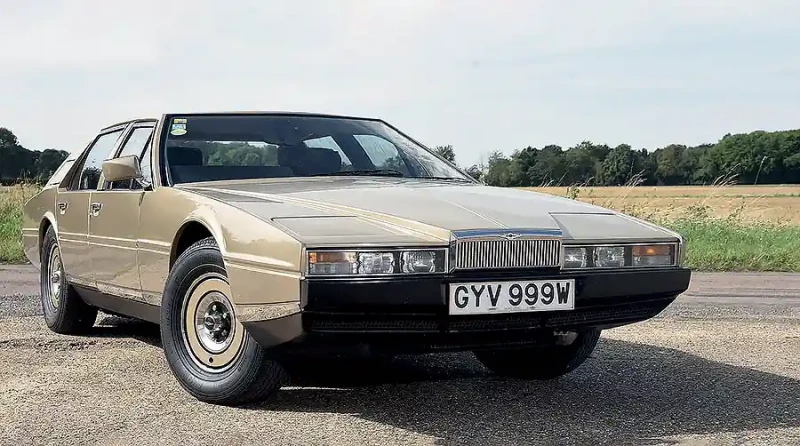
The Lagonda was the work of William Towns, one of the UK’s most creative automotive designers. When he joined Aston Martin in 1966 following stints at Rootes and then Rover it was initially to design car seats. However, he soon approached the company’s then chairman, (Sir) David Brown, with sketches of a new, more modern coupe which eventually became the DBS from 1967.
Towns had also developed a longer, four-door version and in 1969 a single prototype was built for Brown’s personal use that was fitted with a prototype 5.0-litre version of Aston Martin’s new V8. Because Brown had been an enthusiast of the Lagonda marque ever since he’d bought it in 1947, the car was badged as such. It initially remained a one-off until 1974 when, with Aston Martin now owned by an investment bank consortium called Company Developments Ltd, a slightly redesigned version was put into very limited production. At £14,040 – 24 percent more than the contemporary V8 – together with the Middle East oil crisis, it struggled to find buyers and just seven were produced before it was finally deleted from Aston Martin’s line-up in June 1976.
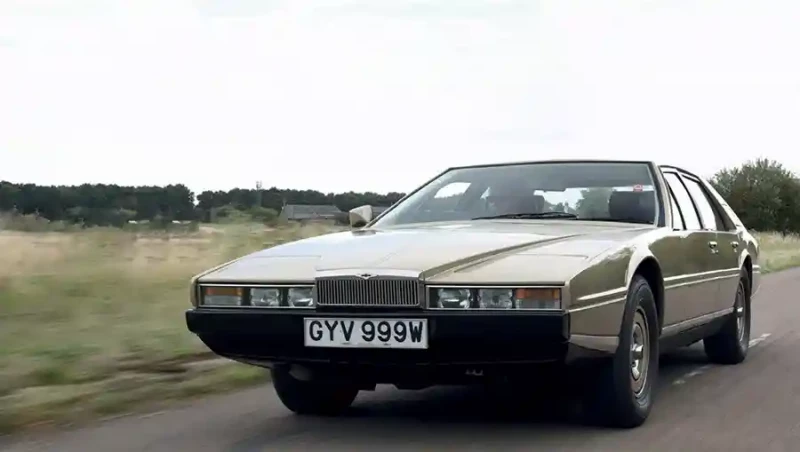
Having been sold again in 1975 after going bankrupt the year before, Aston Martin’s new board of directors – Alan Curtis, Dennis Flather, George Minden and Peter Sprague – didn’t want to give up on the Lagonda brand. And so in February 1976 plans were made for a new model that had an ambitious target of being ready for the British Motor Show just eight months later.
Towns was again asked to design the car but what he came up with was nothing like Aston Martin – or any other company for that matter – had produced before. He’d been toying with the idea of a four-door saloon influenced by the angular sports cars of the period for some time, which included the Lamborghini Countach and Lotus Esprit.
“We had a meeting for a presentation by William Towns,” wrote Peter Sprague in a feature that appeared in the magazine published by the Aston Martin Owners Club of North America. “He produced a drawing of a spectacularly radical four-door design. He had been quietly dreaming up the design on his own over the previous two or three years. We decided to go for it. I believe that the decision was made in a day. There was no dissension. The four company directors all felt that we wanted to own the car in William’s drawings. We wouldn’t ever be able to drive it if we didn’t build it. Thus the Lagonda was conceived.”
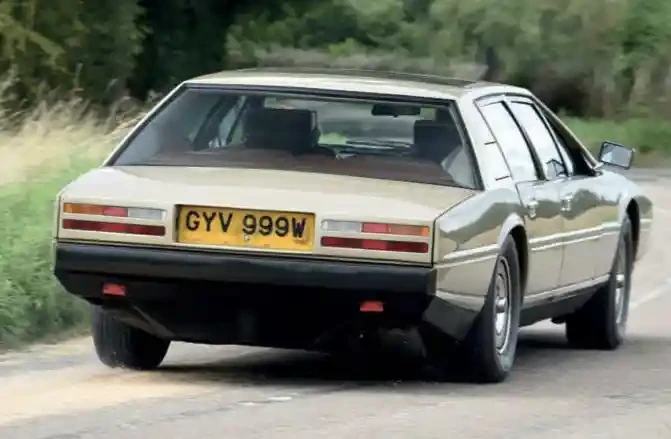
Towns wasn’t new to this kind of design, with his Mini-based prototype, the Minissima of 1972, and rebodied Jaguar E-type Series 3, the Guyson E12, from two years later both featuring very angular lines. The Lagonda, though, took the razor design to another level. “The brief was to radically restyle the longer version of the DBS,” said Towns during a 1976 TV interview. He certainly achieved that.
At 5,283mm long and 1,816mm wide, not only was the car huge, its dimensions larger than those of a Rolls Royce Silver Shadow, but there wasn’t a smooth line anywhere. And although the nose was also very long and low, requiring the use of pop-up headlights, the boot was short and high, resulting in unusual proportions.
“The shape is decided by aerodynamics more than anything else,” said Towns during a 1976 interview. “If you have a high nose you get terrible lift problems, then you get induced drag and it slows the whole thing down.”
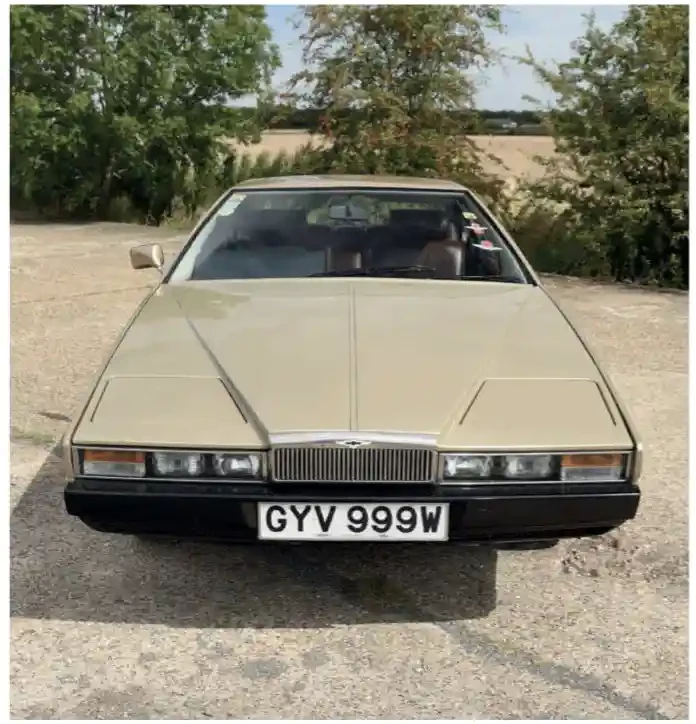
Amazingly, Towns reckoned by working 12 hours a day it took him just a month to finish. Even more amazingly, the production version changed very little from his initial sketches. “The design of the body was very different to everything else,” said Aston’s then chief engineer, Mike Loasby, in David Dowsey’s 2007 book, Aston Martin Power Beauty and Soul. “It was classic William Towns. We altered very little of the design after William’s first presentation. We altered the shape at the front by narrowing it a little and we altered the grille because we thought it wasn’t quite wide enough, but that’s about all. It stayed very muchas he wanted it, which is unusual. I think he was happy with the finished production model.”
Despite the short development span, it still used a brand new and substantial platform designed by Loasby. “We designed a new chassis because the chassis of the V8 was very expensive; we actually designed a two-door version first,” he continued in Power, Beauty and Soul. “The original idea had been to put a new skin on the old chassis because we wanted to give it a new life, but the old chassis was so expensive it was not worth doing.”
The only parts carried over from the existing AMV8 were the differential, gearbox, and some parts of the engine. Said Loasby in Dowsey’s book, “The heads were modified, the inlet manifolds were new, the sump was new and so on. They weren’t carryover parts. Not one little bit.”

To clear the low bonnet line, a lower air box was needed which affected the maximum power on the carburettor version although the later cars with fuel injection were on a par with the Aston Martin. To alleviate the breathing problem caused by the low air box, the Lagonda version of the 5.3-litre V8 was the first to have 2.1in inlet valves which were later used on the AMV8 Vantage before becoming standard across the range. Typically for the time, Aston Martin didn’t release the engine’s power output when the car finally went on sale but it’s thought it produced around 280bhp and 360lb ft of torque.
When Autocar tested the Lagonda for its 18 October 1980 issue, it achieved a top speed of 143mph putting the car on a par with a Jaguar XJ12 Series 2 but its 0-60mph time of 8.8 secs was almost a second and a half slower.
The front suspension was largely sourced from Jaguar which included the top links although Aston’s engineers did design a new bottom link and incorporated new geometry. At the rear there were self-levelling dampers and a De Dion axle. The 15in steel wheels were also from Jaguar but fitted with elegant Towns-designed chrome trims. Later cars came with the same ‘Pepperpot’ style of alloy as Jaguar was currently using.
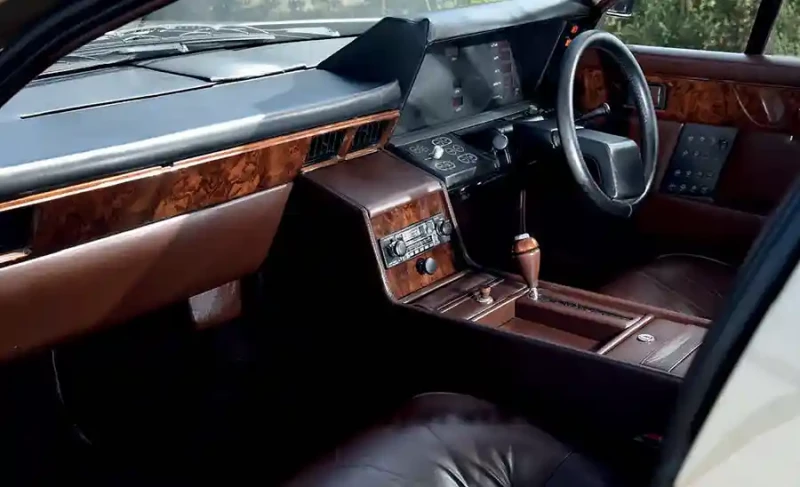
The car’s design wasn’t the only ambitious aspect about the Lagonda, since from the outset it was planned to be an electronic tour de force with never before seen levels of equipment. This included digital read-outs in the dash plus touch-sensitive buttons to control all of the car’s functions. It’s said Mike Loasby got the idea when visiting the headquarters of National Semiconductor in Santa Clara, California, which Aston Martin co-chairman Peter Sprague had also taken over in the mid-Sixties. Loasby was particularly taken by the futuristic touch-sensitive buttons the company used in its elevators.
The instruments were initially developed by Fotherby, Willis Electronics Ltd of West Yorkshire, but financial problems meant they couldn’t finish the project in time.
And so, although Loasby and his team met their deadline and the Lagonda was unveiled to the public at the London Motor Show on 16 October 1976 (the final one to be held at Earls Court), it had dummy electrics.
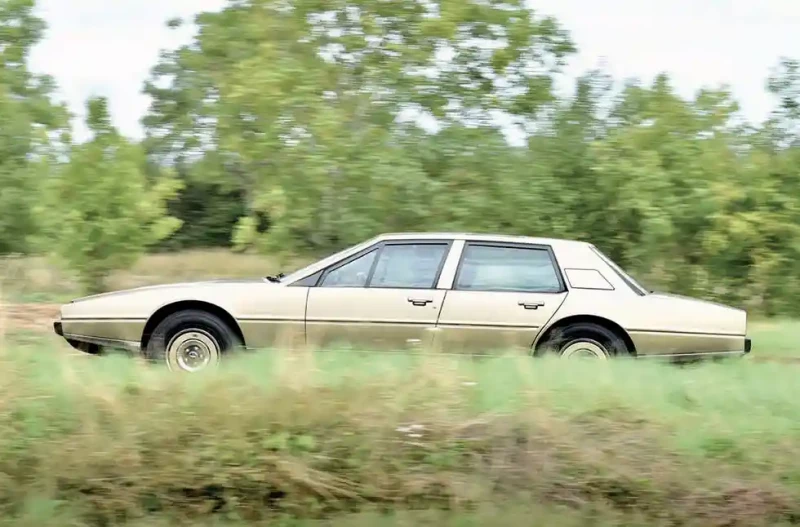
“For the show we had the first car built up to look as though it had the electronics in it, but it didn’t,” explained Loasby in Dowsey’s book. “We had an electronic buck on the stand which was just the passenger compartment of the car without a roof and it had all the electronic displays working on it or looking as if they were.”
Neither could the car run under its own power and when this first prototype appeared to be moving during later appearances on television, it was actually rolling down a hill.
Yet the car was still a triumph. “The star of the show and the best-kept secret of all had to be the sensational Aston Martin Lagonda, practical futurism with sophisticated style and splendid luxury,” was Motorsport magazine’s view in its November 1976 issue. “We all knew that Aston were revising the four-door Lagonda first shown a couple of years ago; in fact Peter Sprague, and his Aston co-directors had thrown this out as a red herring, for the astonishing reality was a totally new body/chassis unit of superbly, proportioned-wedge shape.”
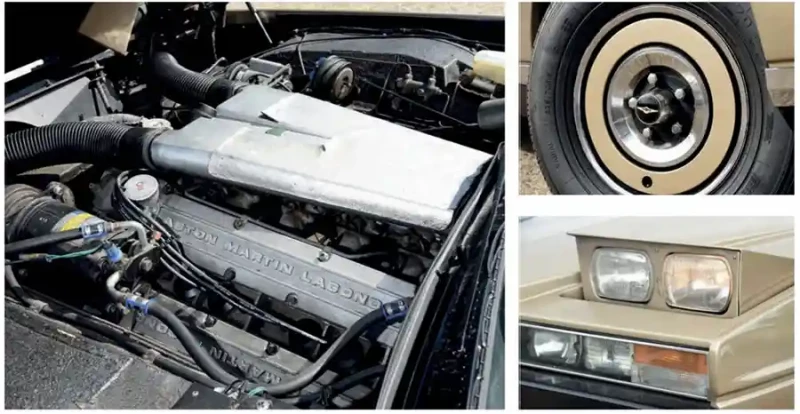
British Prime Minister James Callaghan sat in it while Colin Chapman brought his chief engineer, Mike Kimberly, over to Aston’s stand to take a look, asking why Lotus couldn’t have done the same exciting instrumentation.
So popular was the car that despite costing £20k when a Daimler Double-Six Vanden Plas was ‘just’ £10,800, Aston still took over 76 orders, giving the directors the confidence to finish developing it for production. However, due to the complicated electrics, it would take another 18 months before the first car would reach its customer.
As Alan Curtis said later, “The company promised delivery dates for the Lagonda at the 1976 Motor Show that we didn’t have a cat in hell’s chance of keeping. During 1977 we went through a crucial development phase with the car, and I must confess that at times I thought we made an appalling mess of the whole thing. We’d underestimated the time it would take to develop the car, which, after all, contained many innovations for the automotive world, and some of the costings were sheer guesswork.”
With Fotherby, Willis Electronics out of the picture, Aston Martin’s cochairman and airplane enthusiast, Alan Curtis, turned to the Cranfield Institute of Technology’s established Centre for Aeronautics for help. Yet it too struggled as Loasby explained in Dowsey’s book. “You should never get any academic on anything because they will never finish the job and they will never get it to work.”
The first multi-chip, 16-bit microprocessor – the IMP-16 printed circuit card – was sourced from National Semiconductor to run the Lagonda’s dashboard electronics. “The team learned quickly that the automotive environment is much more difficult than that of a modern military aircraft,” said Sprague in his AMOC piece. “Everything is supposed to work immediately at temperatures from -30F to +140F.”
By April 1978, Aston’s management felt confident enough to organise a press event at the nearby Woburn Abbey. This was to hand over the first production vehicle to Lady Tavistock, the wife of Robin Russell who was a stockbroker and future 14th Duke of Bedford. She had complained about the length of time it had taken for her to receive the car she’d ordered as a wedding anniversary present for her husband. Aston’s mechanics had worked around the clock to get the car ready but were still unable to make the Cranfield-built electrical harness work since the IMP-16 chip kept glitching as the manufacturing director, David Flint, explained in Power, Beauty and Soul.
“We worked for two days and two nights solid trying to fit this harness from Cranfield Institute of Technology into the car. We had nearly finished when we were told we had better send the car out ‘right now.’ I’d had enough by this time and I said, ‘If you want to push this car out, you can do it yourself. I’m going home.’ So I went home.”
Despite the known issues, the handover still went ahead but in an utterly embarrassing scene, Lady Tavistock’s car had to be pushed in front of the waiting journalists.
“I stated the obvious, ‘We goofed’ or, more specifically, ‘I goofed,’” wrote Sprague about the speech he made to the assembled press. “I held up the malfunctioning computer circuit board by one corner and explained that the computer had packed it in. It had been my bright idea in the first place; the engineers and the factory were innocent. Everything about the car was magnificent with the slight problem that it did not run. It was not the fault of the Aston workforce.” It was only when Aston’s then engineering director, Steve Coughlin, approached Brian Refoy from the Javelina Corporation in Texas who specialised in making and developing aircraft instruments that the electrics were finally sorted. “Aston Martin’s decision to go to the US for the electronics was right,” confirmed Loasby. “Cranfield made a fearful mess of the electronics because, even though they were at the forefront of technology, they had no idea of the realities of what you could or couldn’t do in a car.”
Production finally got going at the end of the year with deliveries starting in 1979, although by now the price had risen from £20k to an eye-watering £50k. This made it a substantial £18k more expensive than a Rolls-Royce Silver Shadow II.
Yet despite the high price, its controversial looks or the time it had taken to reach production, the press was still positive about the car when they finally got to drive one. “There is just one respect in which we feel it has no real rival,” said Autocar in 1980, “and that is in terms of its eye-catching appearance. No Ferrari, no Rolls-Royce and certainly no lesser car caused quite a stir wherever it is parked.”
And judging by the majestic 1980 example featured here, that’s clearly still the case. In the 25 years I’ve been writing about cars for a living, I’ve never driven one that has created so much attention as this one. Passers-by either stared, gave a thumbs up or stopped to ask what it is. But due to the car’s still dramatic design, I don’t blame them. Looking like something from the future, the sort of vehicle Colonel Edward Straker might have driven in the Seventies sci-fi classic UFO, it remains as space-age as its 1976 debut.
Although due to its many hard angles and arrow-straight lines, I can’t describe it as pretty in the same way a Jaguar XJ12 Series 3 from 1979 is, the car still has a genuinely muscular presence. Unfortunately, the narrow nose is ruined when the pop-up lights are raised, their size giving the car something of a bugeyed appearance.
As a long-term enthusiast of William Towns’ work, I openly admit to loving the Lagonda and therefore experience a real moment of excitement when I open the heavy door and slide behind the surprisingly small, single-spoked steering wheel. As I get comfortable on the large seat that’s covered in a softly ruched brown leather and look around me, my first impression is… how basic the dashboard is. Admittedly, there’s a wide strip of rich veneer across the fascia and on all four door tops, but the large and simple black plastic binnacle in front of me that together with the ingenious touch pads on either side make the instrument panel look like an early games console I owned in the Seventies.
It’s only after I turn the key to start the V8, the binnacle now filled with a series of red LED numbers, that it starts to make sense. Admittedly, the many read-outs are small and hard to read in the glare of the sun, but the lack of traditional dials makes the car feel even more futuristic, helped by the traditional milometer hidden under the bonnet like some dirty little secret.
Although the Lagonda weighs a hefty 2,024kg (around 200kg more than the AMV8) the keenness of its acceleration takes me by surprise. The Chrysler Torqueflite three-speed automatic gearbox kicks down the moment I press the throttle hard resulting in a sudden urge of speed I wasn’t expecting. Yet it’s still relatively quiet and refined as Autocar found in its October 1980 issue. “It’s not just the top speed of the Lagonda that is impressive, it also has the ability to cruise extremely fast indeed. We covered long distances at speeds between 100 and 120mph and the front passenger – who cannot see the instruments – is quite unaware that the car is going so fast.”
I had assumed beforehand that the Lagonda would be like a Jaguar XJ12 to drive; smooth, wallowy with all the sharpness of an oil tanker. Yet the steering has the weight and accuracy of a genuine sports car and although the saloon’s bulk together with the soft suspension results in plenty of body roll, the always-composed chassis allows me to swoop through a series of fast S-bend corners with remarkable speed.
Yet what I find most surprising about the car isn’t this performance, the controversial design or its high cost – which by January 1990 when production ended had reached £95,000 – the car was, in Aston terms at least, a relative success.
The car was updated twice, firstly in 1986 when fuel injection replaced the four Weber carburettors which increased power to 305bhp, plus new and improved vacuum fluorescent display instrumentation. The second facelift arrived a year later that saw slightly rounder lines, fixed headlights instead of the pop-ups plus 16in alloys.
The 635 production cars (plus around eight prototypes) made Towns’ Lagonda one of the most successful Aston Martins of the immediate pre-Ford era and helped keep the company afloat throughout the turbulent Seventies and early Eighties, which considering its nicheness is remarkable. Sprague, though, never had any doubt of the car’s potential.
“I have been asked many times whether we had done any market research, was there a detailed budget, and what gave us the confidence that we could do it?” he said in his AMOC feature. “Basically we looked at William Towns’ extraordinary drawings, and we asked Mike Loasby if he and his team could build it. They said ‘yes.’ We had confidence in the team. It was comparable to building the Spitfire during the Battle of Britain.”
Aston Martin’s marketing team might have struggled to describe this unique car when it was new but after finally driving one, I can sum it up in one word. Magnificent.
Thanks to: Roger Ivett for supplying the car shown here
“It was planned to be an electronic tour-de-force with never before seen levels of equipment”


